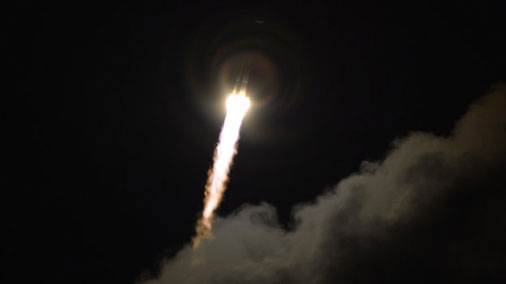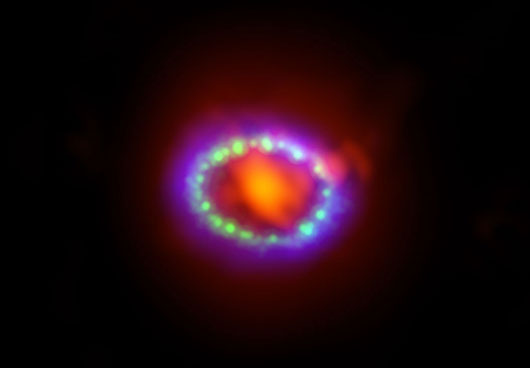



January 2014
GAIA - LIFTOFF!
On 19 December 2013, the European Space Agency's (ESA) Gaia satellite blasted off from Europe's spaceport in French Guiana aboard a Soyuz rocket. It's mission: map a billion stars.
Gaia stands for Global Astrometric Interferometer for Astrophysics. Liftoff occurred at 09:12 GMT. The booster put Gaia into a temporary orbit at an altitude of 175 km where the spacecraft activated its systems. Gaia's final orbital position will be at L2, which is at a gravitationally stable virtual point in space about 1.5 million km beyond Earth as seen from the sun.
A four month commissioning phase began enroute to L2. All systems and instruments will be checked and calibrated. Gaia will then begin a five year mission mapping the stars.

PHOTO: ESA
Visit our sponsors.
For advertising opportunities on this page and our videos, contact
GAIA - Mission
The mission for Gaia is to survey and map about one billion stars in the Milky Way Galaxy. This will create the largest and most accurate three-dimensional map of the galaxy ever compiled. Along the way, Gaia will also detect new asteroids, quasars and even exoplanets. Gaia will also provide a test of Einstein's theory of general relativity.
One billion stars is about 1% of all the stars in our galaxy. Gaia will chart the three-dimensional distribution of these stars and determine their brightness, temperature, composition and motion through space. Each star will be surveyed 70 times, each time recording its brightness, color and position.
The positions of the stars will be accomplished using parallax (measuring each stars position 6 months apart when the earth has moved its farthest distance around the sun. For more information on parallax, watch the Let's Explore Astronomy Rigel episode on "Measuring the Universe".) Gaia will be able to calculate the parallax with accuracy never before achievable. Over 99% of the stars have not been accurately measured. By comparing the data we will soon be able to make precise measurements on the movements of the stars. This will allow astronomers to trace the history of the Milky Way.
Gaia will also measure asteroids. With unprecedented precision, Gaia will measure the positions and velocities of over 200,000 asteroids. The surface properties of the asteroids will be determined by looking at the asteroid's color and brightness data, allowing astronomers to deduce the rotation rates and surface shapes.
Gaia will look at hundreds of thousands of stars within about 500 light years of Earth searching for evidence of planets orbiting them. So far, over 700 exoplanets have been discovered and it is hoped Gaia will add a couple thousand more to that list.
Albert Einstein's General Theory of Relativity states that space itself is not flat, but it has warps and dips in it. These are caused by the gravity of individual objects such as planets, moon and stars, causing starlight to deflect. Gaia contains instruments so precise that they will be able to measure these deflections. This will give astronomers a way to test some of the key parts of Einstein's equations.
Upcoming Launches
Date: January 8
Launch Vehicle: Antares
Launch Site: Wallops Flight Facility, Virginia
Description: Orbital 1 will be the first commercial resupply mission to the International Space Station
Date: January 23
Launch Vehicle: Atlas V
Launch Site: Cape Canaveral AFS, Florida
Description: TDRS-L is the second of three next-generation satellites designed to ensure vital operational continuity for the NASA Space Network
GAIA - Instrumentation
Gaia is two space telescopes in one. There are ten mirrors of various sizes and shapes used to collect, focus and direct light to Gaia's instruments. The telescopes point to two different positions in the sky separated by 106.5 degrees. Each scope has a rectangular primary mirror with a collecting area of about 0.7 square meters. Three flat mirrors and three curved mirrors are used to focus and fold the light beam over a total path of 35 meters. Gaia's telescopes are powerful enough to detect stars up to 400,000 times fainter than those visible to the naked eye.
Gaia incorporates three instruments to detect the light, the astrometric instrument, the Radial Velocity Spectrometer and the photometric instrument. The 106 CCDs that record the light from the stars create the largest focal plane ever flown in space, almost one billion pixels covering 0.38 square meters.
The star's positions are measured by the astrometric instrument. As each star is measured 70 times during the five year mission, the data can be combined to determine an accurate distance as well as the velocity and direction the star is moving across the sky.
The Radial Velocity Spectrometer will measure the Doppler shift of the the absorption lines in a high resolution spectrum covering a narrow wavelength range. This will tell us the velocity of the stars in the direction of moving away or toward us.
Color information is obtained by the photometric instrument. Two low-resolution specta, one in the blue and one in the red are generated. This will reveal the star's temperature, mass and chemical composition.
With instruments like these, measuring the stars at a never before achieved accuracy, Gaia will certainly advance the science of astronomy to new levels. At the end of the five year mission, Gaia will have collected over 1 Petabyte (1 million Gigabytes) of data, enough to fill over 200,000 DVDs.

ESA
HAPPY 10th!!!!

In 2004, two Martian rovers, Spirit and Opportunity, touched down on the red planet to begin their 90 day mission. It is now ten YEARS later and Opportunity continues to trek around the planet exploring and sending back information.
Spirit touched down at Gusev Crater on January 3, 2004. It's mission ended in March of 2010 after traveling 8 km (4.8 miles) and returning 128,000 images.
Opportunity touched down at Meridiani Planum on January 24, 2004. It has clocked 39 km (24 miles) so far and is still roving! It has returned 187,000 images.
HAPPY 10th Anniversary!!!
Search for Martians
Nasa's Curiosity rover is gearing up for a new exploration mission on Mars. Curiosity will soon be on the hunt for organic molecules. Having established that the conditions are right for the landing site to have once been habitable for certain types of microbes, the mission scientists now want to see if they can find some evidence.
The new plan will be put into effect in the next couple of months when the rover arrives at KMS9, a rock outcrop in Gale Crater. Using satellite images and recent new knowledge obtained by Curiosity, KMS9 looks like it has the right "scarp" features.
Searching for organic evidence is very difficult and tricky. Over the billions of years, the fossil record of micro-organisms all but disappear. The only evidence they existed are the large organic molecules left behind after the cells of the organism breaks down and fragments.
On Mars, cosmic rays constantly rain down on the surface obliterating the organic molecules over time. Over the billions of years, the chemical signature is destroyed. So the trick is find a place where the cosmic rays have not destroyed anything yet. This would mean the best place to look is deep underground or places that have recently been exposed due to erosion.
Curiosity has been studying the cosmic ray environment on Mars. This data provides information on how long organic molecules could withstand the cosmic ray radiation on the surface. Curiosity then has dated the rocks in Gale Crater. From there it has been determined that the best place to drill would be just in front of a "scarp". The wind erosion in these locations would only have recently exposed the lower rock and thus the signature of organic molecules will not yet have been destroyed. Data from Curiosity has determined that rock exposed in the last million years could still hold the organic signature.
There are non-biological processes that will produce organic molecules. Therefore finding evidence of organics will not be definite proof that life once existed on Mars. But finding them will certainly advance the possibility greatly.
SUPERNOVA DUST
Galaxies are dusty places. But where did all that dust come from? For the first time, we have now seen the remains of a recent supernova brimming with freshly formed dust.
The Atacama Large Millimeter/submillimeter Array (ALMA) in Chile has been examining the supernova 1987A, located in the Large Magellanic Cloud. The Large Magellanic Cloud is a dwarf galaxy located about 160,000 light-years from Earth. For the first time in history we are able to examine a supernova with unprecedented resolution and sensitivity.
As the gas cooled after the explosion, it was predicted that large amounts of dust would form atoms of oxygen, carbon and silicon bonded together in the cold central regions of the remnant. But as SN 1987A was observed in the infrared during the first 500 days after the explosion, only a small amount of dust was detected.
ALMA, however, is able to look at the cold dust in the millimeter and submillimeter wavelengths. Here they have found the abundant dust they predicted. Astronomers estimate that the remnant now contains about 25 percent the mass of the Sun in newly formed dust. Additionally, significant amounts of carbon monoxide and silicon monoxide have formed.
Mikako Matsuura of the University College London says, "Really early galaxies are incredibly dusty and this dust plays a major role in the evolution of galaxies. Today we know dust can be created in several ways, but in the early Universe most of it must have come from supernovae. We finally have direct evidence to support that theory."

European Southern Observatory
© 2014-2016 Ted Cook Productions LLC. - All Rights Reserved